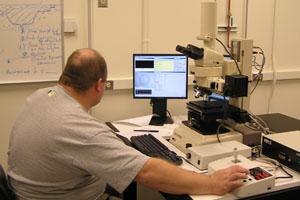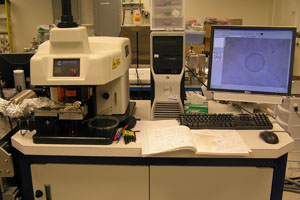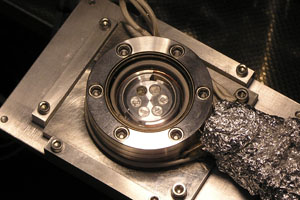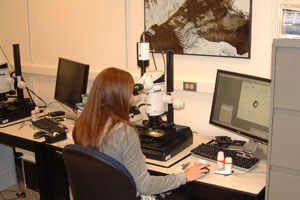
Building on 16 years of experience at MIT, the development of noble gas research capabilities began in 2006 and the laboratories are now nearing completion. Housed in F-Wing of the Bateman Science Center at Arizona State Universities, they are designed to support a wide range of geochronologic and isotopic tracer research by scientists from ASU and national and international collaborators. Conventional and laser microprobe (U-Th)/He facilities are now fully operational. We have recently taken delivery of our first 40Ar/39Ar system and we anticipate dating our first samples in late 2008. When complete (Spring 2009), the laboratories will house four mass spectrometry systems.
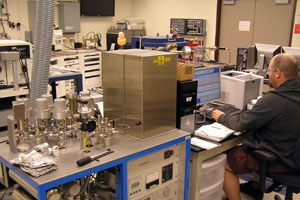
Quadrupole System (Alphachron) – Conventional (U-Th)/He Thermochronology and Diffusion Experiments
"Conventional” (U-Th)/He geochronology refers to single-crystal dating of various phosphate minerals, titanite, and zircon. Helium analyses for this sort of work is done at NG3L with an Alphachron MkII He extraction/measurement system built by CSIRO/Patterson Instruments/ASI. This turnkey system features He extraction using either a Farley-Nenow diffusion cell or 970 nm diode laser, and isotopic measurements using a quadrupole mass spectrometer. U, Th, and Sm is measured on spiked solutions using a Thermo Electron X-7 inductively coupled plasma mass spectrometer (ICP-MS).
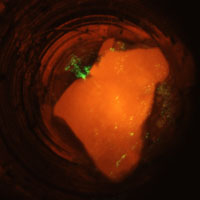
Most conventional 40Ar/39Ar dating will be done using a Nu Instruments Noblesse magnetic sector mass spectrometer. The Noblesse is one of the most advanced commercially available instruments for such work. It features four collectors (one Faraday and three ion counting multiplier detectors) and is ideally suited for high-precision work. The She-Ra system is especially designed for incremental heating and fusion analyses of single crystals and small multigrain aliquots, the sorts of measurements commonly employed for dating volcanic rocks or for detrital mineral thermochonology. Gasses are liberated from a sample using an infrared (970 nm) diode laser with optics and stage automation by Photon Machines or by a double-vacuum furnace system custom built by Brent Turrin of Rutgers.

Standard Magnetic Sector System II (Sherlock Holmes) – Laser Microprobe 40Ar/39Ar Geochronology
Laser microprobe 40Ar/39Ar dating are done using a second Noblesse attached to a special, low-volume extraction system ideally suited for very small sample volumes. Working with polished grain mounts or thin sections, high spatial-resolution analyses are performed using an ArF (193 nm) excimer laser subsystem. Based on the ATLEX ultra-short pulse excimer, this subsystem was designed by Photon Machines. In particular, this instrument should be especially well suited for dating deformational fabrics defined by K-rich minerals, and for depth profiling experiments aimed at recovering Ar diffusion gradients.
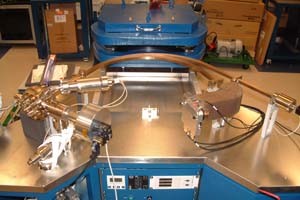
At MIT, the Hodges group – especially then-student Jeremy Boyce and research scientist Bill Olszewski – developed a promising laser microprobe technique for high spatial-resolution (U-Th)/He dating. We are continuing to refine this technique at ASU, focusing especially on achieving better precision. Toward this end, we use a newly designed analytical system that features a New Wave Research ArF (193 nm) excimer laser for sample ablation, and a split flight tube mass spectrometer – the Thermo Electron (GV Instruments) Helix SFT – for simultaneous measurement of 4He and 3He. For this method, the volumes of ablated pits are measured with an ADE Phase Shift MicroXAM interferometric microscope. U, Th, and Sm are measured with one of two SIMS instruments in the Secondary Ion Mass Spectrometry facility in the School of Earth and Space Exploration at ASU.
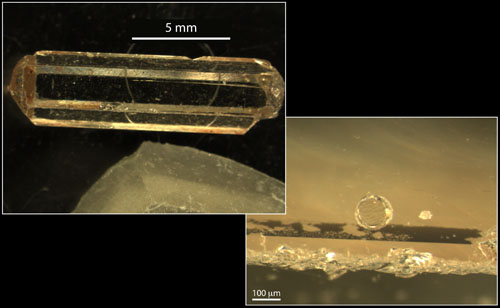
The Helix SFT is also extremely
well-suited to He, Ne, Kr, and Xe isotope geochemistry, and the
He-Man system also incorporates alternative crusher and furnace
extraction subsystems to enable a broad spectrum of noble gas
isotopic studies of minerals and fluids. For example, we have had
great early success at quantifying He diffusion and natural alpha
ejection gradients in crystals by precise excimer laser depth
profiling using the He-Man system. The images to the right show a
single crystal of Durango fluorapatite which we have used for three
depth profiling experiments on the upward-facing natural crystal
face. The close-up image (lower right) reveals one of the ablation
pits at the end of the depth profiling experiment.
Contact
Us Regarding Contract or Collaborative Research Using
NIG3L
Facilities
